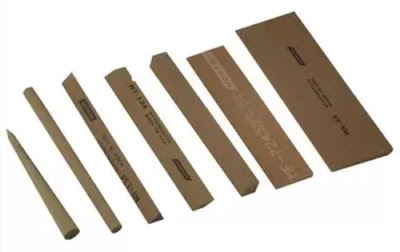
If it turns on a shaft, it probably has
bearings. Bearings wear out with use and are considered a
“consumable” item, they are designed to be replaced on equipment
that is intended to be used for any length of time. The cheap,
imported gear (tools, rolling stock, and machinery) is often not
designed for long life. It's often cheaper to throw away a modern
tool than it is to repair it- this is by design. “Planned
obsolescence” was a marketing strategy that gained a wide following
in the 1970s, that's the idea that in order to get repeat sales you
need to make everything so poorly that it will fail shortly after the
warranty expires. This is why I shop flea markets and estate sales
for older tools and equipment, I have a better chance of finding
something that will be usable for many more years rather than having
to throw it out. I have power tools and kitchen appliances older than
most of our readers that are still working, try finding anything in a
store today that you'll be able to pass down to your kids or
grandkids.
Bearings are simple, I covered the
basic types last week, and most of them are replaceable. The work of
replacing them can be dirty, greasy, and a pain in the neck but is
generally worth the effort. Being able to do some of your own basic
repairs makes you a little bit more independent and opens up
opportunities to rehabilitate things that others have no further use
for. Fixing up a trailer, wagon, bicycle, or vehicle might come in
handy if our normal system of supply crashes. We invented the wheel
to make life simpler, it would suck to lose them.
Most bearings are assembled in a hub
that connects the wheels to the axle/shaft. I'll use a diagram of a
common trailer hub/axle to explain the parts and procedures, bicycles
and vehicles are very similar with minor differences due to the load
they carry.
 |
Courtesy of Tiedown.com
|
This is a boat trailer hub, the dust
cover is water-tight and designed for ease of adding grease to push
out any water that may have gotten into the hub. Other trailers and
most vehicles use a simple metal cup-shaped dust cover (this is the
original “hub cap”). Dust covers are most commonly pressed or
hammered onto the hub, there are no threads, so removing them takes a
small hammer and a pry bar. Gently tapping on the pry bar to force it
into the joint where the cap meets the hub will give you enough of a
gap to pry the cap off. Work around the cap as you tap and pry, don't
try to do it all from one spot or you'll damage the cap.
Once you get the cap off, you should
see a mess of grease and metal parts. If you don't see any grease,
you either have sealed bearings or it was assembled wrong. Grease is
cheaper than bearings, so I was taught to always pack grease in
until you can't see the bearings. This keeps water and air away from
the metal to prevent rust, but also makes it a mess to work on.
Current training is to always wear vinyl gloves when working with oil
and grease (latex won't last very long, it dissolves), but I normally
just clean my hands rather than wear plastic gloves. Wipe away as
much of the grease as you can so you can see what you're working
with.
Once you can see the retaining nut,
give the hub a good shake front-to-rear and side-to-side. Any wobble
you can feel is too much wear on the bearings. The retaining nut is
locked in place by either a cotter key (if the nut is “castellated”
and has notches cut in one end) or a locking collar underneath it (if
it is a standard nut).
Cotter keys are rarely reusable, but
you might get lucky, I've seen a lot of nails and bits of wire used
when replacement cotter keys aren't available. Cotter keys are a
piece of soft steel or aluminum wire that has been bent back on
itself. Inserted through a hole in the axle, the “legs” of the
hey are then spread apart to keep it from falling out. To remove it,
use small pliers to straighten the legs back out and pull it back
through the hole in the hub, twisting as you pull.
Locking collars look like washers with
tabs around the edge. Once the retaining nut is in the proper
position, one or more of those tabs is bent up against the flats of
the nut to keep it from turning. To remove the nut you'll have to
find the tabs and use a chisel or pry bar to push them back down.
Removing the retaining nut should be
simple, they're not forced on with a lot of torque and they come off
easily. Once you've done that the hub will come off of the axle. The
outer bearing is behind a thick washer and will drop out without
effort, but the inner bearing should have a dust/oil seal behind it
and those can be more difficult to pop off. Tapping around the back
of the hub with a hammer, sometimes with a bit of force, will pop the
inner seal off of its shoulder on the axle and let you remove the
hub.
Now that you have the hub off, it's
time to decide what needs to be done to it. If there wasn't much free
play in the hub when you tried to shake it, you can get by with
cleaning and re-greasing the bearings. If the bearings or races (cups in the picture above) are
discolored from heat (usually blue tints, but any color other than
shiny metal), are rusted, or are obviously damaged they'll need to be
replaced. Remove as much grease as you can using rags and/or solvents
if they're available. A stiff brush and a bucket of diesel fuel is a
quick way to remove a lot of old grease, but be safe while doing so,
Outer bearing will fall out easily.
There are bearing pullers designed to gently extract the inner
bearings and both races, but a hammer and long punch will do in a
pinch. The hub has precision-bored holes for the races to sit in, but
there will be notches in the bottom of each hole. The bearing
extractors have “fingers” that catch the lip of the races at
these notches and pull them out. Using a hammer and punch from the
back side, you can gently tap on that lip exposed at the notches,
alternating between the notches with each tap. The goal is to slide
the races out of the holes as evenly as possible without getting it
cocked to one side.
Modern bearings will have part numbers
laser-etched into one of the flat surfaces, any decent parts store
can find you replacement parts if you have the numbers. If there are
no visible numbers, check parts catalogs and the manufacturers
information to find them, otherwise you're going to need a good set
of calipers to carefully measure inner and outer diameters of the
bearings and races. Taking those measurements to a GOOD parts store
will get you replacements, but you'll have to find someone who knows
their job. If you plan on having this piece of equipment around for
years, having extra bearings on hand at home is cheap insurance.
OK, the old ones are out and you have
the new ones in hand. Reassembly is pretty straightforward, but you
need to grease the bearings before installing them. The old-school
method is to place a large blob of fresh grease in the palm of one
hand and swipe the outer edge of the bearings through the blob to
force grease up into the bearing. Dig that edge into the grease,
pushing down against your palm to make sure the grease is going up
into the bearing. Modern shops have toys that “pack” the bearings
without the mess.
Races are a “press-fit”, so they
need to be forced into the hub. Having a hydraulic press makes life
easier and ensures that the races go in straight, but you can get the
job done with a hammer and some properly-sized pieces of steel. I
look for large sockets that are the same size as the outer diameter
of the races and use them to guide the races into the hub. Slow and
gentle taps on the sockets while checking alignment will get them
seated. I have seen people use sockets on each race with a threaded
rod run through the centers. Tightening nuts on the threaded rod will
gently force the races into position.
Once both races are in, place the
packed inner bearing into its race and install the oil/dust seal.
This is another press-fit, but seals are very thin metal so you have
to be extra careful to keep them straight. At this point, I normally
add extra grease to the cavity in the hub between the bearings.
Filling that cavity ensures that the grease in the bearings stays
there and doesn't flow out when the bearings warm up.
Place the hub on the axle and push it
on until the oil seal pops up onto its shoulder. Next you install the
outer bearing and washer, followed by the retaining nut.
Tighten the retaining nut until it
touches the washer. Sometimes you'll be able to find a torque setting
for the retaining nut, but on most trailers you want it snug enough
to eliminate wobble but not so tight that you're putting excess
pressure on the bearings. If you have a cotter key set-up, tighten
the nut until it touches the washer, then turn it until you have the
holes lined up for the cotter key. Install the cotter key and bend
the legs to keep it from moving. Locking tabs are about the same, get
the nut tight enough to hold everything in position and find a tab
that you can bend up to keep the nut from turning.
Pack some extra grease in around the
retaining nut to protect it and place the dust cap into place. Using
a rubber hammer and tapping on the dust cap as you spin the hub will
get it seated. Put the tire back on and that job is done.
There you go, you're ready to get
rolling again. Doing this yourself saves a lot of money and gives you
confidence in your equipment. Taking it to a shop is less messy, but
the rates they charge is getting ridiculous. Spending a couple of
hours in the garage learning how to do it yourself will also give you
the knowledge you need if you ever have to do it away from home. I've
done a few trailers on the side of the road and more than a few
pieces of agricultural equipment literally out in a field.




























